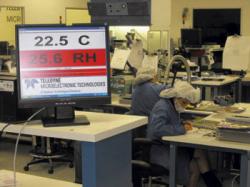|
|
Teledyne Microelectronic Technologies, a Teledyne Technologies Inc. company, is a microelectronics manufacturer specializing in products and services for the defense, space, aviation, medical, and broadband communications markets. Because these markets are highly regulated, Teledyne maintains a quality management system certification to SAE AS9100, ISO 9001, and major OEM customer specifications.
The challenge for Teledyne was to balance quality, compliance, and costs. Environmental monitoring is crucial because of the electrostatic discharge damage that can occur when temperature and relative humidity levels do not meet minimum/maximum criteria. The ambient humidity levels can decrease significantly throughout the year.
Teledyne had numerous locations monitored by chart recorders. One of the main flaws in this system was that if conditions went out-of-tolerance (OOT), there was no way of knowing unless someone continuously checked the chart recorder. Any period of OOT conditions could compromise product quality and cause line stoppages until remedied.
…

Comments
Add new comment